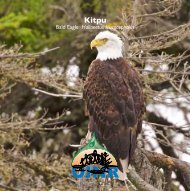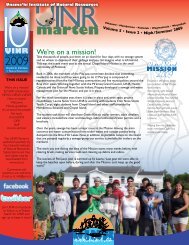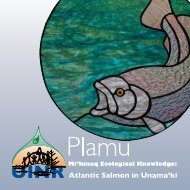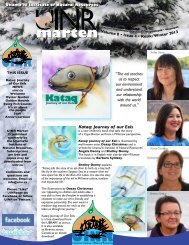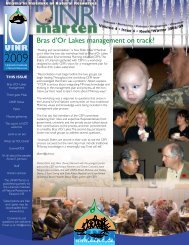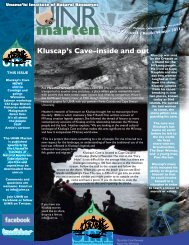Mi'kmaq Ecological Knowledge Distribution of Culturally Significant ...
Mi'kmaq Ecological Knowledge Distribution of Culturally Significant ...
Mi'kmaq Ecological Knowledge Distribution of Culturally Significant ...
You also want an ePaper? Increase the reach of your titles
YUMPU automatically turns print PDFs into web optimized ePapers that Google loves.
Overall results <strong>of</strong> the Fieldwork and Ground Truth Analyses varied among the individual<br />
plant species where some species were elusive to the field crews, but scored “Very Good”<br />
in the Predictive Rating category <strong>of</strong> the Ground Truth Analysis. It was rare that a plant<br />
species found and recorded in the field had three or more supportive habitat map layers<br />
at the exact plant location. However, it was more likely that an additional supportive<br />
habitat map layer was within a short distance <strong>of</strong> 31m (100 ft.) to the plant location.<br />
Ground Truth Results<br />
As previously described in the Methodology, Field Crews chose fieldwork stage 2 and<br />
3 target points that were accessible by public roads, and recorded any other culturally<br />
significant plants found near the target points. New GPS points were not created for<br />
target species not found, nor were new GPS points created for other plant locations<br />
found near the target point. New GPS points that were created are representative <strong>of</strong> all<br />
culturally significant plants found within the vicinity <strong>of</strong> the original target species point.<br />
However, in post processing <strong>of</strong> the collected field data, each individual plant was separated<br />
from other plants represented by the field GPS point, and each provided a new GIS point<br />
with the same coordinates as the original GPS point.<br />
An example <strong>of</strong> a fieldwork scenario is that a field crew stopped on the road side, or<br />
walked a short distance into nearby woods or field looking for a target species. The field<br />
crew spots several species within the vicinity <strong>of</strong> the target at various distances, such<br />
as across the road, at the edge <strong>of</strong> the field, or within a few paces <strong>of</strong> the target point.<br />
Occasionally, plants not included in any <strong>of</strong> the priority plant lists were recorded out <strong>of</strong><br />
interest but not included in further GIS mapping or Ground Truth results.<br />
A system <strong>of</strong> rating the predictive ability <strong>of</strong> the Grey Tone method chosen for this project<br />
must consider field data collection methods in which each point is not necessarily an exact<br />
location <strong>of</strong> a plant species found. Another consideration is the various scales <strong>of</strong> the habitat<br />
data utilized in the Grey Tone mapping. Some <strong>of</strong> the data sources are at provincial scale<br />
whereas the Cape Breton data was extracted from a larger province-wide source, such<br />
as the Surficial Geology data used for this project. Other sources <strong>of</strong> data are at a national<br />
or provincial scale, but the detail provided is comparable to a local scale where individual<br />
habitats such a field, quarry or forest clear-cut are identifiable.<br />
To analyze the utility <strong>of</strong> the project GIS database and mapping method in predicting and<br />
locating <strong>Culturally</strong> <strong>Significant</strong> Plant Species to the Mi’kmaq, the following criteria was used<br />
to assess the Ground Truth results:<br />
Ground Truth Predictive Rating –Aug. 05 to Oct. 21, 2010<br />
Accumulation <strong>of</strong><br />
Habitat Support Layers<br />
Habitat Support<br />
Layer at Point<br />
Location<br />
Proximity <strong>of</strong> Nearest Additional<br />
Habitat Support Layer<br />
Within<br />
31m (100ft)<br />
Beyond<br />
31m (100ft)<br />
0 Habitat Support Layers Poor Fair Poor Poor<br />
1 Habitat Support Layer Fair Good Fair Fair<br />
2 Habitat Support Layers Good Very Good Good Good<br />
3+ Habitat Support Layers Very Good Very Good Very Good Very Good<br />
Where a High Priority or Medium Priority plant was not located in the field, or fewer<br />
than three locations were found, plant locations derived from Cape Breton University<br />
(CBU) Archives were mapped and included with the assessment <strong>of</strong> Ground Truth points.<br />
Lower Priority plants were not targeted in the field work and not all were located in the<br />
field. Similar to the High and Medium Priority plants, CBU archive points were utilized<br />
to represent Lower Priority plants with fewer than three Ground Truth point locations.<br />
Latitude and Longitude coordinate locations <strong>of</strong> CBU archive points are rounded <strong>of</strong>f to<br />
the nearest minute and were mapped with a 60-second window where the plant location<br />
may exist. For this reason the same criteria for assessing Ground Truth results utilized for<br />
field points was utilized for CBU archive plant point locations with the addition <strong>of</strong> the 60-<br />
second window:<br />
n/a’s<br />
47



